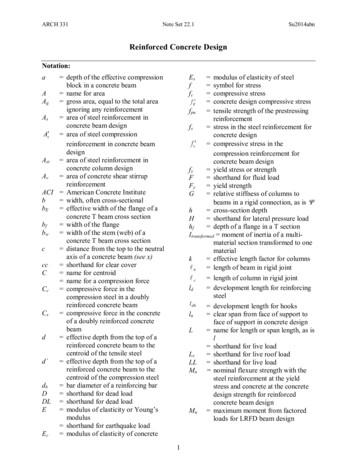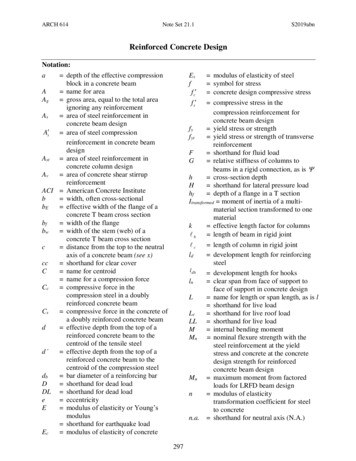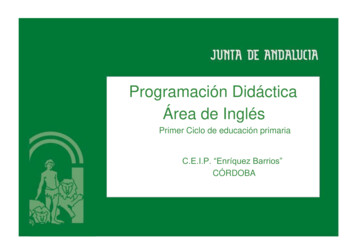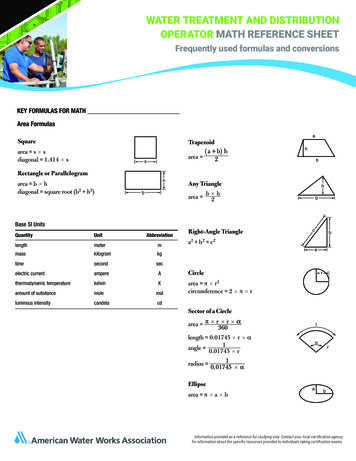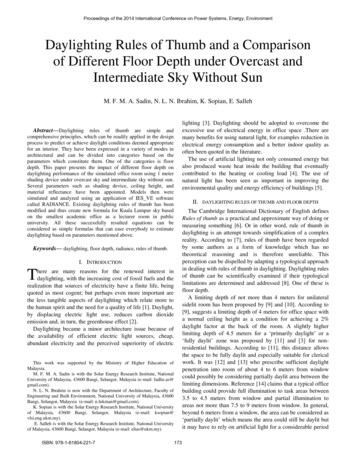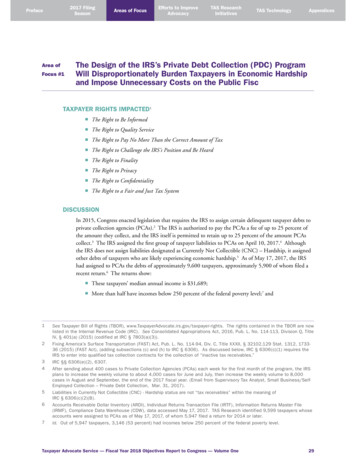
Transcription
2017 FilingSeasonPrefaceArea ofFocus #1Areas of FocusEfforts to ImproveAdvocacyTAS ResearchInitiativesTAS TechnologyAppendicesThe Design of the IRS’s Private Debt Collection (PDC) ProgramWill Disproportionately Burden Taxpayers in Economic Hardshipand Impose Unnecessary Costs on the Public FiscTAXPAYER RIGHTS IMPACTED1 The Right to Be Informed The Right to Quality Service The Right to Pay No More Than the Correct Amount of Tax The Right to Challenge the IRS’s Position and Be Heard The Right to Finality The Right to Privacy The Right to Confidentiality The Right to a Fair and Just Tax SystemDISCUSSIONIn 2015, Congress enacted legislation that requires the IRS to assign certain delinquent taxpayer debts toprivate collection agencies (PCAs).2 The IRS is authorized to pay the PCAs a fee of up to 25 percent ofthe amount they collect, and the IRS itself is permitted to retain up to 25 percent of the amount PCAscollect.3 The IRS assigned the first group of taxpayer liabilities to PCAs on April 10, 2017.4 Althoughthe IRS does not assign liabilities designated as Currently Not Collectible (CNC) – Hardship, it assignedother debts of taxpayers who are likely experiencing economic hardship.5 As of May 17, 2017, the IRShad assigned to PCAs the debts of approximately 9,600 taxpayers, approximately 5,900 of whom filed arecent return.6 The returns show:1234567 These taxpayers’ median annual income is 31,689; More than half have incomes below 250 percent of the federal poverty level;7 andSee Taxpayer Bill of Rights (TBOR), www.TaxpayerAdvocate.irs.gov/taxpayer-rights. The rights contained in the TBOR are nowlisted in the Internal Revenue Code (IRC). See Consolidated Appropriations Act, 2016, Pub. L. No. 114-113, Division Q, TitleIV, § 401(a) (2015) (codified at IRC § 7803(a)(3)).Fixing America’s Surface Transportation (FAST) Act, Pub. L. No. 114-94, Div. C, Title XXXII, § 32102,129 Stat. 1312, 173336 (2015) (FAST Act), (adding subsections (c) and (h) to IRC § 6306). As discussed below, IRC § 6306(c)(1) requires theIRS to enter into qualified tax collection contracts for the collection of “inactive tax receivables.”IRC §§ 6306(e)(2), 6307.After sending about 400 cases to Private Collection Agencies (PCAs) each week for the first month of the program, the IRSplans to increase the weekly volume to about 4,000 cases for June and July, then increase the weekly volume to 8,000cases in August and September, the end of the 2017 fiscal year. (Email from Supervisory Tax Analyst, Small Business/SelfEmployed Collection – Private Debt Collection, Mar. 31, 2017).Liabilities in Currently Not Collectible (CNC) - Hardship status are not “tax receivables” within the meaning ofIRC § 6306(c)(2)(B).Accounts Receivable Dollar Inventory (ARDI), Individual Returns Transaction File (IRTF), Information Returns Master File(IRMF), Compliance Data Warehouse (CDW), data accessed May 17, 2017. TAS Research identified 9,599 taxpayers whoseaccounts were assigned to PCAs as of May 17, 2017, of whom 5,947 filed a return for 2014 or later.Id. Out of 5,947 taxpayers, 3,146 (53 percent) had incomes below 250 percent of the federal poverty level.Taxpayer Advocate Service — Fiscal Year 2018 Objectives Report to Congress — Volume One29
AppendicesTAS ResearchInitiativesTAS Technology Efforts to ImproveAdvocacyAreas of Focus2017 FilingSeasonPrefaceMore than a fifth have incomes below the federal poverty level.8In addition to assigning “inactive tax receivables” to PCAs as required by statute, the IRS plans to useits discretionary authority to assign to PCAs the recent debts of taxpayers who already have a prior debtassigned to a PCA.9 Regular IRS collection processes, which in fiscal year (FY) 2016 generated about 4.7billion of receipts, will be circumvented.10 PCAs will thus receive commissions on payments the IRS couldhave collected merely by sending its usual notices, and the IRS will be able to retain up to 25 percent ofcollections that normally would go directly to the public fisc. Thus, under this procedure, up to half of thecollections that would normally go to the public treasury will now be retained by PCAs and the IRS.The IRS Is Assigning to Private Collection Agencies (PCAs) the Debts of Taxpayers WhoAre Likely Experiencing Economic HardshipTAS Research identified 5,947 taxpayers whose debts had been assigned to a PCA as of May 17, 2017 andwho had filed tax returns for 2014 or later.11 Figure 3.1.1 shows the income distribution of these taxpayers.FIGURE 3.1.112Income Distribution of Taxpayers Whose Debts Were Assigned to PCAsCompared to the Federal Poverty Level, According to Their Last Filed Returns(Tax Year 2014 or Later) 0- 10,000 10,001- 20,000 20,001- 30,000 30,001- 40,000 40,001- 50,000 50,001- 60,000 60,001- 70,000 70,001- 80,000 80,001- 90,000Taxpayers Whose Incomes Were LessThan the Federal Poverty Level forTheir Household Size 90,001- 100,000 100,001- 110,000Taxpayers Whose Incomes Were at orAbove the Federal Poverty Level But WereLess Than 250% of the Federal PovertyLevel for Their Household Size 110,001- 120,000 120,001- 130,000 130,001- 140,000Taxpayers Whose Incomes Were 250%or More of the Federal Poverty Levelfor Their Household Size 140,001- 150,000 150,001 089101112305001,000ARDI, IRTF, IRMF, CDW, data accessed May 17, 2017. Out of 5,947 taxpayers, 1,373 (23 percent) had incomes below thefederal poverty level.Since 2004, IRC § 6306(a) has authorized the IRS to enter into qualified tax collection contracts with PCAs. See TheAmerican Jobs Creation Act of 2004, Pub. L. 108-357, Title VIII, § 881(a)(1), 118 Stat. 1418, 1625-27 (2004) (enacting IRC§ 6306).IRS Collection Activity Report (CAR) NO-5000-2/242, Balance Due Notices (Oct. 3, 2016), discussed below.IRS, ARDI, IRTF, IRMF, CDW, data accessed May 17, 2017. These debts carry a Transaction Code of 971 and an ActionCode of 54 on the IRS’s Master File database.U.S. Dept. of Health and Human Resources, Poverty Guidelines (2017), https://aspe.hhs.gov/poverty-guidelines. The federal poverty level is based on family size and varies from year to year. Federal poverty level determinations shown in the chartcorrespond to the family size and tax year for the taxpayer’s most recently filed return. As discussed below, 250 percent ofthe federal poverty level is a proxy for economic hardship for purposes of excluding some taxpayers’ federal payments fromthe Federal Payment Levy Program (FPLP).Section Three — Areas of Focus
Preface2017 FilingSeasonAreas of FocusEfforts to ImproveAdvocacyTAS ResearchInitiativesTAS TechnologyAppendicesAs Figure 3.1.1 shows, more taxpayers belong to the income category of less than 10,000 than anyother category. These 1,041 taxpayers comprise 18 percent of the total, and the incomes of all but eightof them are below the federal poverty level. Almost half of the taxpayers — 2,827, or 48 percent — haveincomes of 30,000 or less. Of these taxpayers, only 45 have incomes equal to or more than 250 percentof the federal poverty level.To its credit, the IRS ultimately agreed with the National Taxpayer Advocate that it is inappropriateto assign to PCAs the liabilities of taxpayers who receive Social Security Disability Income (SSDI).13Because of the IRS’s earlier refusal to exclude these debts, however, the necessary programming was notin place by April 10, 2017. Thus, as of May 17, 2017: The debts of 445 taxpayers who received SSDI in 2016 were assigned to PCAs; and Of these 445 taxpayers, 160 filed recent returns; the median income shown on these returns wasless than 10,600.14The National Taxpayer Advocate also expressed concern about assigning to PCAs the liabilities oftaxpayers who were not subject to levies on their Social Security Administration (SSA) retirementpayments pursuant to the Federal Payment Levy Program because their incomes were at or below 250percent of the federal poverty level.15 In response, the IRS decided that for the first six months of thePDC program, these taxpayers’ debts would be included in the PCA inventory. During that time, theIRS could explore how to identify taxpayers in this group who also have substantial assets. The IRS didnot take any steps to develop such a method and ultimately informed TAS that it will not exclude thesetaxpayers’ debts from assignment to PCAs.16 In the meantime:1314151617 The IRS assigned to PCAs the liabilities of 875 taxpayers who received SSA in 2016; and Of these 875 taxpayers, 326 filed recent returns; the median income shown on these returns wasless than 13,200.17Taxpayers receiving Social Security Disability Income (SSDI) by definition generally cannot earn over 1,170 per month( 1,950 if he or she is blind) without having their SSDI payments reduced. See Social Security Administration (SSA), Update2017, https://www.ssa.gov/pubs/EN-05-10003.pdf.IRS, ARDI, IRTF, IRMF, CDW, data accessed May 15, 2017. The 160 returns were filed for tax year 2014 or later. The IRSadjusted its guidance to PCAs, the PCA Policy and Procedures Guide (PPG), to require the return of cases in which the taxpayer states he or she is a recipient of SSDI or Supplemental Security Income.See Internal Revenue Manual (IRM) 5.19.9.3.2.3, Low Income Filter (LIF) Exclusion (Oct. 20, 2016). The 250 percent measure operates as a proxy for economic hardship.SB/SE response to TAS information request (Apr. 5, 2017); SB/SE response to TAS information request (May 15, 2017),(stating that “[t]axpayers receiving SSA retirement income will not be screened from the PDC program.”).IRS, ARDI, IRTF, IRMF, CDW, data accessed May 17, 2017. The 326 returns were filed for tax year 2014 or later.Taxpayer Advocate Service — Fiscal Year 2018 Objectives Report to Congress — Volume One31
AppendicesTAS TechnologyTAS ResearchInitiativesEfforts to ImproveAdvocacyAreas of Focus2017 FilingSeasonPrefaceThe IRS Plans to Assign New Receivables to Private Collection Agencies (PCAs), ThusAllowing PCAs to Collect Amounts the IRS Could Collect by Sending Its Usual NoticesOnce a taxpayer’s liability is assigned to a PCA, the IRS will assign that taxpayer’s new assessments, ifany, to the PCA. The IRS describes the process as follows: A taxpayer owes income taxes for 2012 and the IRS transfers that liability to a PCA on April 10,2017; The same taxpayer files a return for 2016 on April 15, 2017. The return shows a liability of 5,000 but the liability is not paid with the return; If the taxpayer does not pay the 2016 liability by May 15, 2017, the IRS issues Notice CP 14, ademand for payment of the 5,000 liability; and If payment is not received, the IRS assigns the 5,000 to the PCA, notifies the taxpayer of theassignment, and will pay commissions to the PCA on payments the taxpayer makes with respectto the 2016 liability on or after July 14, 2017.18The taxpayer’s 2016 liability in the example above would not be an “inactive tax receivable.”19 Thus, theIRS may, but is not required by statute, to assign it to a PCA.20 As explained below, it is questionablewhether doing so is a good business decision.When taxpayers incur delinquent tax liabilities, the IRS demands payment over a period which spans aboutsix months in a series of four notices. IRS Notice CP 14 is the first such notice, and is the only noticethe IRS intends to issue in the example above.21 In FY 2016, the Notice CP 14 resulted in 3.8 billion ofpayments.22 Notices generated after the CP 14, however, resulted in 4.7 billion of payments.23 The IRSplans to suppress those notices, allow the PCAs to solicit payments that might have been made in responseto them, and pay the PCAs a commission on the amounts collected. Figure 3.1.2 shows the amounts theIRS receives for each of the four notices it issues to taxpayers whose debts are not assigned to PCAs.18192021222332SB/SE response to TAS information request (Apr. 5, 2017).IRC § 6306(c)(2)(A) provides that “[t]he term ‘inactive tax receivable’ means any tax receivable if (i) at any time afterassessment, the Internal Revenue Service removes such receivable from the active inventory for lack of resources orinability to locate the taxpayer, (ii) more than 1/3 of the period of the applicable statute of limitation has lapsed and suchreceivable has not been assigned for collection to any employee of the Internal Revenue Service, or (iii) in the case of areceivable which has been assigned for collection, more than 365 days have passed without interaction with the taxpayer ora third party for purposes of furthering the collection of such receivable.”IRC § 6306(c) provides: “Notwithstanding any other provision of law, the Secretary shall enter into one or more qualified taxcollection contracts for the collection of all outstanding inactive tax receivables.” IRC § 6306(a) is the source of the IRS’sgeneral authority to assign receivables to PCAs, providing “In general.—Nothing in any provision of law shall be construed toprevent the Secretary from entering into a qualified tax collection contract.”SB/SE response to TAS information request, (Apr. 5, 2017).CAR NO-5000-2/242, Balance Due Notices (Oct. 3, 2016). The data does not distinguish between collections from taxpayers who had liabilities for periods that preceded the notice stream and those who did not.Id., showing that the second, third, and fourth notices in the notice stream (CP 501, CP 503, and CP 504) combined resulted in payments of about 4.7 billion. The data does not distinguish between collections from taxpayers who had liabilitiesfor periods that preceded the notice stream and those who did not.Section Three — Areas of Focus
Preface2017 FilingSeasonAreas of FocusEfforts to ImproveAdvocacyTAS ResearchInitiativesTAS TechnologyAppendicesFIGURE 3.1.224Amounts Collected From Taxpayers Whose Debts Are Not Assigned to PCAsand Who Are Issued Four IRS Collection Notices (in Millions of Dollars) 3,786 2,256 1,911 491First Notice(CP 14)Second Notice(CP 501)Third Notice(CP 503)Fourth Notice(CP 504)Treating the same taxpayer’s liabilities differently may not be justified in the light of actual taxpayerbehavior. For example, even though the older debt of the taxpayer in the example above has beenassigned to a PCA, the amount of the taxpayer’s recent debt ( 5,000 in the example) may be less thanthe older debt. The taxpayer may therefore be able to pay the additional tax while it is still in thenotice stream. Moreover, the new 5,000 liability in the example above is self-assessed, not the resultof an audit or other assessment process.25 As a recent TAS study demonstrated, the IRS is more likelyto collect self-reported liabilities than other types of assessments. For example, it collects self-assessedliabilities at a rate at least twice as great as it collects audit assessments.26Therefore, by bypassing the notice stream, the IRS: Circumvents its normal procedures for collecting new debts which have proven to be effective; Treats taxpayers whose debts were assigned to PCAs differently than taxpayers whose debts werenot assigned; Treats the same taxpayer’s tax liabilities differently depending on when they arose; and Imposes unnecessary costs on taxpayers and the public fisc in the form of commissions it paysPCAs.The IRS, however, benefits from this approach because it retains up to 25 percent of the amount PCAscollect to be used for hiring and training Compliance employees.27 Thus, the PCAs and IRS benefitfrom this truncated procedure; the public fisc, on the other hand, does not.24252627IRS, CAR NO-5000-2/242, Balance Due Notices (Oct. 3, 2016). The data does not distinguish between collections from taxpayers who had liabilities for periods that preceded the notice stream and those who did not.Other sources of assessment include Automated Underreported assessments, trust fund recovery penalty assessments,and assessments based on a substitute for return. See National Taxpayer Advocate 2015 Annual Report to Congress vol. 2,45 (Research Study: IRS Collectibility Curve).Id.IRC §§ 6306(e)(2), 6307.Taxpayer Advocate Service — Fiscal Year 2018 Objectives Report to Congress — Volume One33
AppendicesTAS TechnologyTAS ResearchInitiativesEfforts to ImproveAdvocacyAreas of Focus2017 FilingSeasonPrefaceThe Private Debt Collection (PDC) Program Raises Concerns About the Adequacy ofAuthentication Procedures, Training of Private Collection Agency (PCA) Employees, andTransparency of PCA PracticesThe IRS letter that notifies a taxpayer his or her tax debt has been assigned to a PCA contains thename, address, and phone number of the PCA and includes a ten-digit Taxpayer AuthenticationNumber (TAN).28 The first letter the PCA sends the taxpayer confirms that the debt was assigned toit, and contains the same TAN as the one listed on the IRS notice. When the PCA later speaks withthe taxpayer by telephone, each party to the call can provide five digits of the TAN (the first five or thelast five) as part of the authentication process. This allows each party to confirm the identity of theother. However, if the taxpayer cannot provide the TAN, the authentication process may, if the taxpayeris willing, be completed by having the taxpayer provide his or her Social Security number (SSN) orTaxpayer Identification number (TIN).29 Thus, the IRS cannot advise taxpayers that legitimate PCAswill never request their SSNs or TINs.30Permitting authentication to proceed on the basis of the taxpayer’s SSN or TIN (rather than using theTAN) heightens the potential for taxpayers to be victimized by scammers posing as PCA employees.Moreover, additional IRS resources will be needed downstream to assist taxpayers who are victims ofidentity theft as a result of having used their SSN or TIN to authenticate their identities with what theybelieved was a PCA.In January 2017, a TAS executive and TAS program analyst travelled to Austin, Texas to deliver inperson training to PCA managers. The training included a 45-minute video of the National TaxpayerAdvocate explaining how the Taxpayer Bill of Rights applies to PCA employees and activities. TASrequested that all PCA employees be required to view the video as part of their training, but the IRSrefused to impose this training requirement.31Transparency about how PCAs intend to interact with taxpayers also remains a concern. The PCAshave shared their calling scripts and the letters they plan to send to taxpayers with the IRS, as required,and the IRS shared these materials with TAS.32 However, some scripts reference job aids that appearto provide more detailed instructions about how to interact with taxpayers, and it is not clear whetherthe IRS requested the job aids from the PCAs.33 In any event, the IRS did not share those job aids withTAS. Additionally, there may be other job aids that are not explicitly referenced in the scripts. Thesejob aids have not been shared with TAS, and it appears that the IRS has not reviewed or conducted any28293031323334IRS Notice CP 40.If the taxpayer does not agree to provide his or her Social Security number or Taxpayer Identification number, the PCA willoffer to resend the PCA initial contact letter which contains the TAN, and suspend further discussion for five calendar daysto allow time for the taxpayer to receive the PCA initial contact letter. See PPG section 6.4.2, Additional Authentication Code.In any event, the PCA cannot continue to collect the debt until authentication is completed.In contrast, the IRS in the past advised taxpayers: “The IRS will never: Call or email you to verify your identity by askingfor personal and financial information.” (emphasis in original). See IR-2016-40, Consumer Alert: Scammers Change Tactics,Once Again, ammers-change-tactics-once-again (Mar. 14, 2016).SB/SE response to TAS information request, (Apr. 5, 2017). The video, National Taxpayer Advocate Message to PCAContractors - Taxpayer Bill of Rights, MessageToPCAContractorsTaxpayerBillOfRights. However, one PCA appears to be including the video in its training. Another PCA, to its credit,committed to displaying IRS Publication 5170, Taxpayer Bill of Rights, throughout its workplace, including in each PCAemployee cubicle. Publication 5170 is a bilingual (English and Spanish) brochure that displays as a poster and lists andexplains the ten taxpayer rights in the TBOR.PPG section 5, PCA Letters.When TAS requested the job aids, the IRS at first responded that “Job aids are not a part of the PCA Deliverables and notsomething the PDC Project Office will be requesting nor reviewing prior to Go Live.” Email from Supervisory Tax Analyst, SB/SE Collection – Private Debt Collection (Mar. 13, 2017). The IRS later indicated that the job aids might be forthcoming.Section Three — Areas of Focus
Preface2017 FilingSeasonAreas of FocusEfforts to ImproveAdvocacyTAS ResearchInitiativesTAS TechnologyAppendicesoversight with respect to them.34 Another development of concern is the IRS’s change in position aboutallowing TAS representatives to listen to calls between PCA employees and taxpayers. While the IRSinitially agreed to allow TAS to participate in this oversight, it now refuses.35CONCLUSIONAs the National Taxpayer Advocate predicted, the design of the PDC program will disproportionatelyaffect taxpayers who appear to be experiencing economic hardship. The IRS plans to assign newliabilities to PCAs without first attempting to collect them through the usual notice stream, therebyunnecessarily paying significant amounts of commissions to PCAs. The IRS has not taken the necessarysteps to ensure that PCAs adequately protect taxpayers, train their employees, and operate transparently.FOCUS FOR FISCAL YEAR 2018In Fiscal Year 2018, TAS will:3435 Accept PDC cases under existing TAS criteria, including criterion nine (applicable when theNational Taxpayer Advocate determines compelling public policy warrants assistance to anindividual or group of taxpayers) and analyze the issues presented and resolution of those cases; Analyze a representative sample of taxpayers who receive Social Security retirement paymentswho are not subject to FPLP levies because their incomes are less than 250 percent of the federalpoverty level but whose debts were assigned to a PCA to determine the extent to which thesetaxpayers have substantial assets; Analyze the accounts of taxpayers who made a payment or entered into an installment agreementwhile their liabilities were assigned to PCAs to determine these taxpayers’ median income, theproportion of taxpayers whose income was less than the poverty level or 250 percent of the federalpoverty level, and the proportion for whom allowable living expenses exceed their total positiveincome; and With respect to taxpayers with debts already assigned to PCAs whose new liabilities wereassigned to PCAs, measure the proportion that subsequently fully paid or entered into a paymentarrangement for those new liabilities.For a description of inappropriate PCA practices that appeared in materials other than scripts in the previous PDCinitiative, see Letter from Nina Olson, National Taxpayer Advocate, to Sen. Ron Wyden, Chairman, Committee on Finance;Sen. Orrin G. Hatch, Ranking Member, Committee on Finance; Rep. Dave Camp, Chairman, Committee on Ways andMeans; Rep. Sander Levin, Ranking Member, Committee on Ways and Means; Rep. Charles W. Boustany, Jr., Chairman,Subcommittee on Oversight, Committee on Ways and Means; Rep. John Lewis, Ranking Member, Subcommittee onOversight, Committee on Ways and Means (May 13, 2014).Email from Supervisory Tax Analyst, SB/SE Collection – Private Debt Collection (Mar. 22, 2017).Taxpayer Advocate Service — Fiscal Year 2018 Objectives Report to Congress — Volume One35
A taxpayer owes income taxes for 2012 and the IRS transfers that liability to a PCA on April 10, 2017; The same taxpayer files a return for 2016 on April 15, 2017 . The return shows a liability of 5,000 but the liability is not paid with the return; If the taxpayer does not pay the 2016 liability by May 15, 2017, the IRS issues Notice CP 14, a



